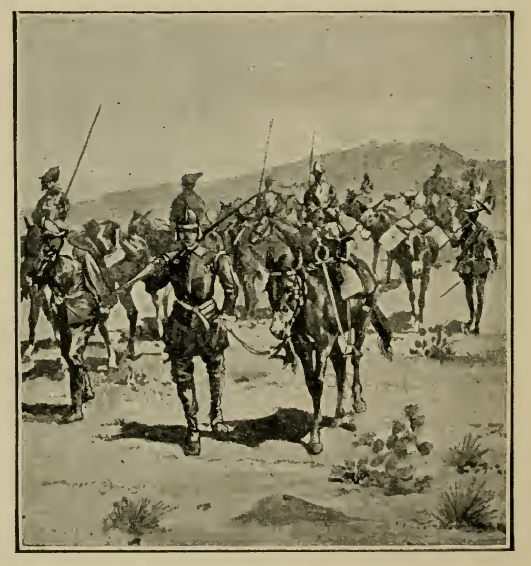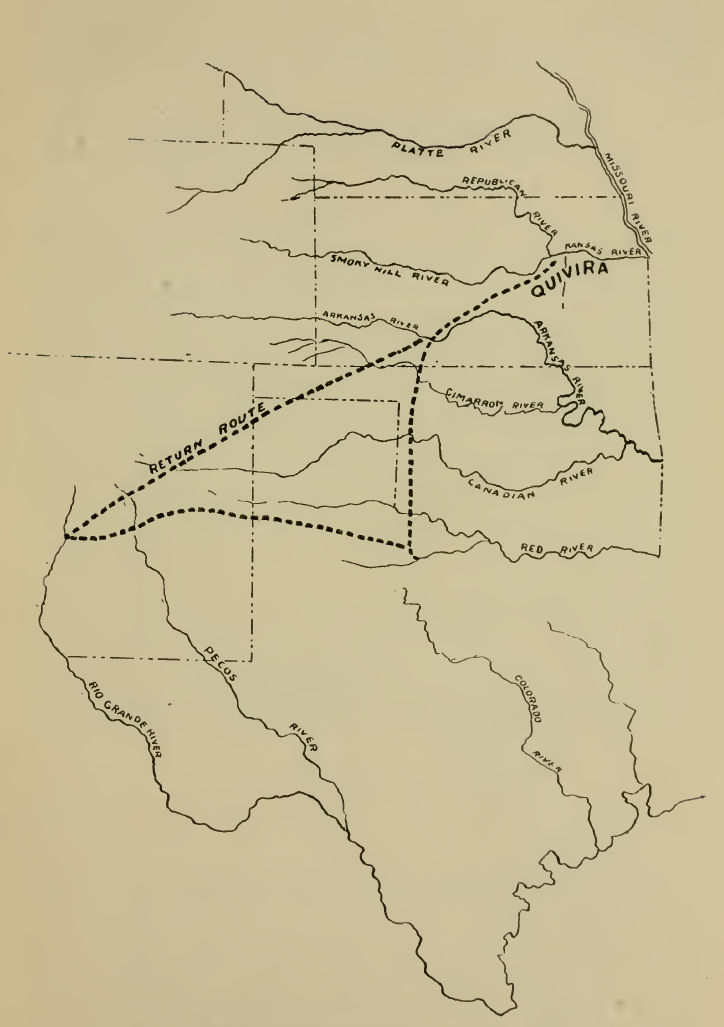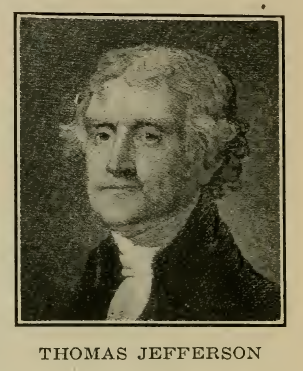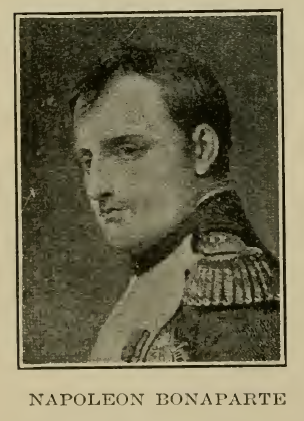| FIRST PERIOD |
| (1541-1803) |
| SPANISH AND FRENCH EXPLORATIONS. |
| The Spaniards in America. —After the discovery of America by Columbus, in 1492, nearly fifty years passed before any explorers pushed their way inland from the coast of the United States. In the meantime, the people of Spain had been exploring the west India Islands, Mexico, Central and South America, where they made settlements. The first of these settlements, or colonies, were planted in the West India Islands—in Cuba, Porto Rico and Santo Domingo. Many of the Spaniards of that day were eager for the adventures with which they were sure to meet in exploring a strange, new country. All of them longed for wealth which they believed to abound in the unknown regions of the great continent to the west of them. |
| Early Spanish Explorers. —Ponce de Leon (pon’-sa-da-la’-on) headed an expedition to Florida, in 1513, where he hoped to "find a mythical fountain whose waters were said to possess the magic power of restoring youth to the aged. In 1519, Fernando Cortez (fer-nan-do kor’-tas) landed on the eastern coast of Mexico at the head of a small army of Spaniards with which he conquered that country and secured a great deal of gold. Narvaez (nar-va-ath) with a force of 400 men visited the Gulf coast of the United States. This venture ended in disaster, only four members of the exploring party surviving to reach the Spanish settlements in Mexico. The tales told by these survivors led to the undertaking of new exploring expeditions northward from Mexico. The most important of these was that which, under the command of Francisco de Coronado (fran-ces-co da ko-ro-na-tho) passed across Oklahoma in 1541. |
 |
| CORONADO’S MARCH |
| Coronado’s Expedition. —With a force of 300 Spanish officers and soldiers, accompanied by 1,000 Indians, Coronado marched northward into New Mexico in 1540. Instead of the rich cities which had been vainly pictured by the golden dreams of the Spaniards, Coronado found only humble, mud-walled Pueblo Indian villages, in which there was no gold. After spending the winter in the valley of the Rio Grande, Coronado marched with his little army in search of the mythical land of Quivira, where gold was said to abound. His course led eastward across the Texas Pan-handle into what is now Oklahoma: thence northward and |
 |
| ROUTE TRAVERSED BY CORONADO |
| northeastward into Kansas, whence he returned by a more direct route to the Rio Grande. Thus it was that, in 1541, the region now known as Oklahoma was first visited by white men. |
| Other Spanish Explorers. —After Coronado’s time there were other Spanish expeditions which extended their explorations into or across the country which is now called Oklahoma. Most of these were merely in search of gold or adventure and no attempt was made to plant any settlements or colonies. |
| The French in America. —The first French settlements in America were made in the valley of the St. Lawrence River, in Canada, about the same time the English were planting their first colonies on the Atlantic coast. From their settlements on the St. Lawrence the French extended their explorations further inland, first to the region of the Great Lakes and then to the valleys of the Mississippi and its principal tributaries. New Orleans was settled in 1717 and the country now known as Oklahoma was claimed as a part of Louisiana from that time on. |
| French Explorers in Oklahoma. —The first French explorers entered Oklahoma on the valleys of the Arkansas and Red rivers. Bernard de La Harpe (bar-nar da la-harp) ascended the Red River from Louisiana, in 1719, in command of an exploring party which visited Southern Oklahoma. Two years later, in 1721, La Harpe led another party of French from Louisiana with which he explored the Arkansas River as far up as the mouth of the Canadian River, making the journey in canoes. |
| The French Trappers and Traders. —Within a short time after the exploration of the rivers of Eastern Oklahoma, trappers and traders in search of furs began to visit that region. They generally kept close to the navigable streams, as they always traveled and carried their belongings in canoes. They were engaged in trapping beaver, otter, mink and other fur-bearing animals and also in trading trinkets to the Indians for furs and peltries. |
| The French Indian Policy. —It was the constant aim of those in authority in the French colonies in America to treat the Indians kindly and hold their confidence and good will. The English and Spanish colonists, on the other hand, very generally treated the Indians as inferiors, often showing neither the spirit of generosity nor that of justice, but rather one of harshness. The French policy of friendliness proved to be a wise one. It paid in a business way, for the French traders were more prosperous than those of the English or Spanish colonies. It rendered wars between the French and the Indians much less frequent than those between the Indians and the colonists of England and Spain, and caused the Indians to remain firm in their friendship to the French in time of war with the colonies of those nations. |
 |
| AMERICAN BUFFALO OR BISON |
 French and Spanish Rivalry. —From the time of the first appearance of French explorers in the valley of the lower Mississippi, the Spaniards of Mexico manifested a spirit of intense jealousy. The activities of the French in exploring the region west of the Mississippi and in cultivating the friendship of the Indians aroused a warlike spirit in the Spanish colonies. Although the French settlements along the Mississippi were nearly a thousand miles from their own settlements in the valley of the Rio Grande, the Spanish governors and people were not willing to share with the French the ownership of the great wilderness lying between them, so several clashes occurred between their forces. French and Spanish Rivalry. —From the time of the first appearance of French explorers in the valley of the lower Mississippi, the Spaniards of Mexico manifested a spirit of intense jealousy. The activities of the French in exploring the region west of the Mississippi and in cultivating the friendship of the Indians aroused a warlike spirit in the Spanish colonies. Although the French settlements along the Mississippi were nearly a thousand miles from their own settlements in the valley of the Rio Grande, the Spanish governors and people were not willing to share with the French the ownership of the great wilderness lying between them, so several clashes occurred between their forces. |
 Louisiana Changes Owners. —At the close of the French and Indian War, in 1763, when France gave up Canada to Great Britain, the province of Louisiana ceased to be a French possession, having been formally ceded to Spain by the King of France to keep the British from taking it. During the next thirty-seven years Louisiana belonged to Spain, though its people, language and customs continued to be French. On October 1, 1801, Napoleon Bonaparte compelled the King of Spain to give Louisiana back to France, though he had to keep the transaction secret lest Great Britain, which was then at war with France, might at once seek to take it by force of arms. Finally, concluding that the ownership of such a distant colony would be difficult to defend, Napoleon entered into a deal for the sale of Louisiana to the United States of America, the contract for such sale being formally signed May 2, 1803. Thus all the present state of Oklahoma except that part embraced in the present counties of Bewer, Texas and Cimarron (which was then a part of the Spanish-Mexican domain) became American territory. Louisiana Changes Owners. —At the close of the French and Indian War, in 1763, when France gave up Canada to Great Britain, the province of Louisiana ceased to be a French possession, having been formally ceded to Spain by the King of France to keep the British from taking it. During the next thirty-seven years Louisiana belonged to Spain, though its people, language and customs continued to be French. On October 1, 1801, Napoleon Bonaparte compelled the King of Spain to give Louisiana back to France, though he had to keep the transaction secret lest Great Britain, which was then at war with France, might at once seek to take it by force of arms. Finally, concluding that the ownership of such a distant colony would be difficult to defend, Napoleon entered into a deal for the sale of Louisiana to the United States of America, the contract for such sale being formally signed May 2, 1803. Thus all the present state of Oklahoma except that part embraced in the present counties of Bewer, Texas and Cimarron (which was then a part of the Spanish-Mexican domain) became American territory. |
| Indian Wars. —The only Indian wars that touched the Oklahoma country during this period of wliich there is any record were those which occurred between the Spaniards of the Rio Grande Valley and the Comanches who roamed over the Plains of Western Oklahoma. These Indians made war on the Spanish settlements very frequently, their principal object being plunder. After the Indians secured horses from the Spaniards and learned to use them, they could go much farther and faster on their warlike raids than they could do when they had to journey on foot. For this reason the Spanish settlements in New Mexico lived in constant dread of the raiding Comanches. |
| The First Trading Post. —About the year 1796, a trading post was established by the Chouteaus (shii-to) of St. Louis, on the east bank of the Grand (or Neosho) River. This trading post, which was situated near the present town of Salina, in Mayes County, was the first white settlement in Oklahoma. |
| Summary. —The first period in the history of Oklahoma covers over 260 years. The Frenchman and the Spaniard saw all sides of Oklahoma, but they left little to show for it except the meager records of their explorations. Our interest in them and in their explorations lies in the fact that they visited and beheld the country which we now call our own. We are often reminded of them by names which still appear on the map of Oklahoma bestowed by them upon certain streams and mountains. Their records served only to guide the men of another race and speech who were to come later. To us, the one great event of the period is the purchase of Louisiana, whereby the vast region in which Oklahoma is included became a part of the American republic. |
SUGGESTIVE QUESTIONS
First Period. |
| 1. To what nationality did the first white men who explored Oklahoma belong! From what direction did they come? How did they travel? |
| 2. When did Coronado start to search for Quivira? What induced him and his men to undertake such a journey? What part of Oklahoma did Coronado’s expedition traverse? |
| 3. Who was the first French explorer to visit Oklahoma? what rivers did he explore? How did his party travel? |
| 4. In what business or occupation did the first French settlers of the Mississippi Valley engage? How did the French settlers treat the Indians? Why was that the wise course to pursue? |
| 5. How far were French colonies in the Mississippi valley from those of Spain in New Mexico? Why were the Spaniards jealous of the French? |
| 6. How did the acquisition of horses affect the Indians? |
| 7. Of what French colony or province was Oklahoma claimed to be a part? What happened to the province of Louisiana in 1763? When did Louisiana again become a French possession? Who was at the head of the French government at that time? |
| 8. When was the first trading post established in Oklahoma? By whom was it established? Where was it located? |
| 9. What did the French consul do with the province of Louisiana? Who was president of the United States when this deal was consummated? |



 French and Spanish Rivalry. —From the time of the first appearance of French explorers in the valley of the lower Mississippi, the Spaniards of Mexico manifested a spirit of intense jealousy. The activities of the French in exploring the region west of the Mississippi and in cultivating the friendship of the Indians aroused a warlike spirit in the Spanish colonies. Although the French settlements along the Mississippi were nearly a thousand miles from their own settlements in the valley of the Rio Grande, the Spanish governors and people were not willing to share with the French the ownership of the great wilderness lying between them, so several clashes occurred between their forces.
French and Spanish Rivalry. —From the time of the first appearance of French explorers in the valley of the lower Mississippi, the Spaniards of Mexico manifested a spirit of intense jealousy. The activities of the French in exploring the region west of the Mississippi and in cultivating the friendship of the Indians aroused a warlike spirit in the Spanish colonies. Although the French settlements along the Mississippi were nearly a thousand miles from their own settlements in the valley of the Rio Grande, the Spanish governors and people were not willing to share with the French the ownership of the great wilderness lying between them, so several clashes occurred between their forces. Louisiana Changes Owners. —At the close of the French and Indian War, in 1763, when France gave up Canada to Great Britain, the province of Louisiana ceased to be a French possession, having been formally ceded to Spain by the King of France to keep the British from taking it. During the next thirty-seven years Louisiana belonged to Spain, though its people, language and customs continued to be French. On October 1, 1801, Napoleon Bonaparte compelled the King of Spain to give Louisiana back to France, though he had to keep the transaction secret lest Great Britain, which was then at war with France, might at once seek to take it by force of arms. Finally, concluding that the ownership of such a distant colony would be difficult to defend, Napoleon entered into a deal for the sale of Louisiana to the United States of America, the contract for such sale being formally signed May 2, 1803. Thus all the present state of Oklahoma except that part embraced in the present counties of Bewer, Texas and Cimarron (which was then a part of the Spanish-Mexican domain) became American territory.
Louisiana Changes Owners. —At the close of the French and Indian War, in 1763, when France gave up Canada to Great Britain, the province of Louisiana ceased to be a French possession, having been formally ceded to Spain by the King of France to keep the British from taking it. During the next thirty-seven years Louisiana belonged to Spain, though its people, language and customs continued to be French. On October 1, 1801, Napoleon Bonaparte compelled the King of Spain to give Louisiana back to France, though he had to keep the transaction secret lest Great Britain, which was then at war with France, might at once seek to take it by force of arms. Finally, concluding that the ownership of such a distant colony would be difficult to defend, Napoleon entered into a deal for the sale of Louisiana to the United States of America, the contract for such sale being formally signed May 2, 1803. Thus all the present state of Oklahoma except that part embraced in the present counties of Bewer, Texas and Cimarron (which was then a part of the Spanish-Mexican domain) became American territory.